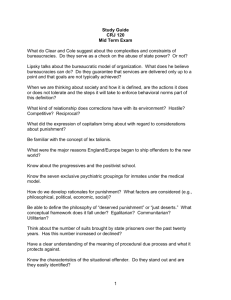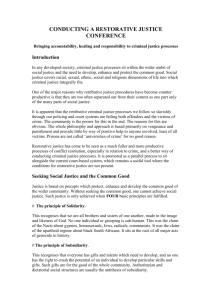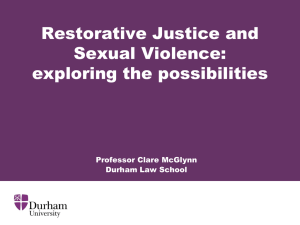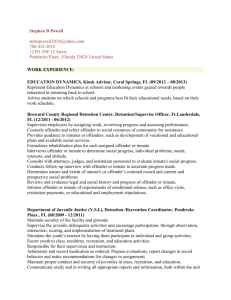Educational Discipline using the Principles of Restorative Justice
advertisement
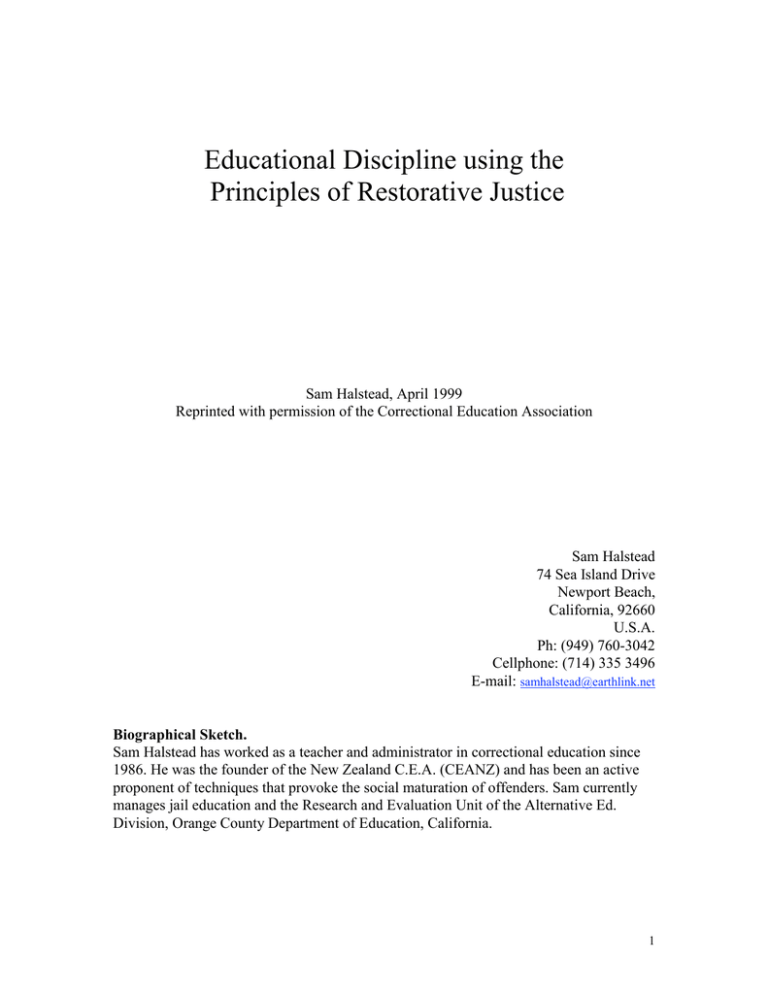
Educational Discipline using the Principles of Restorative Justice Sam Halstead, April 1999 Reprinted with permission of the Correctional Education Association Sam Halstead 74 Sea Island Drive Newport Beach, California, 92660 U.S.A. Ph: (949) 760-3042 Cellphone: (714) 335 3496 E-mail: samhalstead@earthlink.net Biographical Sketch. Sam Halstead has worked as a teacher and administrator in correctional education since 1986. He was the founder of the New Zealand C.E.A. (CEANZ) and has been an active proponent of techniques that provoke the social maturation of offenders. Sam currently manages jail education and the Research and Evaluation Unit of the Alternative Ed. Division, Orange County Department of Education, California. 1 Educational Discipline using the Principles of Restorative Justice ABSTRACT. This article shows how restorative justice techniques can be used with students in correctional and alternative education settings. The simple principles of restorative justice are outlined and their suitability for offenders is illustrated through actual prison incidents that have been dealt with using these principles. A protocol is suggested for teachers and administrators who might consider adopting this approach. 2 Educational Discipline using the Principles of Restorative Justice •= We want them to be responsible So we take away all responsibilities •= We want them to be positive and constructive So we degrade them and make them useless •= We want them to be non-violent So we put them where there is violence all around them •= We want them to be kind and loving people So we subject them to hatred and cruelty •= We want them to quit being the tough guy So we put them where the tough guy's respected •= We want them to quit hanging around losers So we put all the "losers" under one roof •= We want them to quit exploiting us So we put them where they exploit each other •= We want them to take control of their lives So we make them totally dependent Dennis A. Challeen (ref:1) Restorative Justice fits perfectly with the rehabilitative ideal because it concentrates on the harms of crime rather than the rules that have been broken and seeks reparation and balance by involving victims and offenders in the process of justice. Victims are involved in negotiating balance and offenders are encouraged to understand, accept, and carry out their obligations. They get to “learn their lesson”. 3 The restorative approach is not based on punishment, retribution or “just desserts”; it can be looked on as an experiential method for helping offenders to learn social skills, positive values, empathy, and anticipation of consequences. Offenses are treated as teachable moments rather than actions requiring punishment and retribution. The practice is not new, of course. Many of us were raised by parents who believed in the restorative principle – when a wayward rock broke a neighbor’s window we would be steered next door to apologize, and the cost of repair would be deducted from our pocketmoney for as long as it took. We were shamed but not made to feel we were “bad.” The simple lesson learned was “If you break something - you fix it” but, on a deeper level, it reinforced concepts of respect, responsibility, consequences, honesty, and neighborliness. This restorative process and its outcomes were always better than the more prevalent approach which incorporated variations of physical and verbal abuse, solitary confinement, missed meals, curfews, and loss of privileges. Unfortunately the myth is still alive that we can somehow “teach someone a lesson” by treating them badly. By abusing the abusers and victimizing the victimizers. It is good news that the principles of “Restorative Justice” are increasingly being absorbed and applied by jurisdictions around the world. An early example was in New Zealand where the Children, Young Persons, and their Families Act was introduced in 1989. The Act grew out of the dissatisfaction of indigenous Maori people with the punishment orientation of the country’s justice system. The Act allows youthful offenders to be diverted away from the courts and into “family group conferences” which engage 4 them in discussions with their own family, the victim(s), the victim’s family or supporters, and a social worker or probation officer. The conferences focus on outcomes and allow victims and offenders to be involved in the judicial process. The success of Family Group Conferences has resulted in the reduction of New Zealand’s Juvenile Court institutions from 18 to 2 and a 75% decrease in court cases (from over 10,000 to 2587) in only four years. (Maxwell and Morris, 1993) More than fifteen American states have now introduced juvenile justice legislation based on the tenets of restorative justice, and organizations such as the Victim Offender Reconciliation Program (VORP) have offices in most states. There is no question that there is a Restorative Justice movement which is picking up momentum around the world Of course, offending does not just happen in the streets and educators must make sure that restorative justice is not seen as a juvenile diversion technique only. There are implications, and applications, for all educators but particularly those working in jails, prisons, community schools, and court schools. The reoffending nature of our clientele and their common experiences of retributive “justice” provide us with many chances to solve individual and group behavioral problems in the classroom and education center. Too often, when students misbehave, correctional educators resort to the prevailing retributive measures (banning, segregating, laying of charges and loss of privileges) favored by the custodial staff of their institutions. Ineffective measures that, through mindless repetition, have contributed to the increasing resentment and alienation of “problem students.” 5 The moral development theories of Piaget and Kohlberg teach that young children comprehend good and bad in terms of the punishment consequences. As children age and develop through the conventional stages of maturity they, hopefully, learn fairness, moral decision making, law and order, and begin to show more tolerance, empathy and respect for others. The punishment /obedience orientation is the very lowest level of this continuum – the least mature. It is unsophisticated and pre-conventional and, sadly, it is also the way that most correctional institutions operate. Offense matched by retribution. Staff toughness met with inmate resilience. It is apparent that many of our students reside in pre-conventional levels of moral maturity and are well used to their misdemeanors being treated by punishment. How could we possibly expect them to raise their moral awareness to conventional and, preferably, to post-conventional levels, while we continue to apply discipline in the immature, preconventional, punishment/obedience mode? What hope is there that offenders will emerge from our retribution centers more responsible and ethically fit? If offenders do not “learn their lesson” while incarcerated, should we really be puzzled by high re-offending rates? Against the prevailing macho scenario, the principles of Restorative Justice may look weak and tainted with a faint aroma of “new age” liberalism – an unpopular fad in the time of “three strikes” and “truth in sentencing” initiatives. Some correctional educators and program staff are hesitant to even suggest the process to Prison management for fear of being ridiculed. Restorative justice is not a soft option though. Facing up to the hard 6 truth about oneself can be a harrowing experience and it is difficult to “tough it out” in a forum where toughness has no place and a disgruntled victim is staring you down. The following actual incidents illustrate different ways in which the principles of Restorative Justice can be applied in institutional settings: The affectionate sexist: A male, maximum-security inmate, with a long history of sexist behavior, gave a female teacher a hug. The teacher was upset and wanted no further contact with the inmate. A conference was called with the offender, his Unit Manager, the victim, a female colleague and the (male) education center manager. •= The facts of the incident were described to the offender. •= The victim related how she was affected. •= The offender claimed that a hug is innocent and that another female staff member (a Sister in the Prison Chapel) hugs inmates “all the time”. •= The education manager and Unit Manager empathized with him said they had found that it is best to err on the side of caution when dealing with the opposite sex. It is likely, they advised, that a woman would be offended by physical attention unless she is a good friend. •= Both women commented on types of unwanted attention that women are sometimes subjected to and how it makes them feel. •= Sexual harassment was described to him as being unwanted or unwelcome contact or comments of a sexual nature. A brochure about Sexual Harassment was given to him. 7 •= The offender then said he understood and that he had meant no harm. He thought he was being courteous and complimentary. He apologized to the victim and said he now saw why she was so upset and promised not to do it again. •= He continued to attend Education classes and apologized at least three more times in the following week. From that day on he behaved appropriately and was more friendly to all jail staff. The disgruntled gang-leader A male education staff member was manhandled by an inmate gangleader in a prison cellblock. The inmate picked the staff member up from behind in a bear hug and pulled him, struggling, down a landing. The staff member was released, annoyed but unharmed, and attempted to downplay the incident. When the staff member turned his back, the offender repeated the action two more times with increasing vigor. The staff member made a complaint, the incident was treated by custodial staff as an assault, and the inmate was sent to the “hole”. There was talk of banning him from education for six months and a discussion on whether to bring in an outside Court Judge to lay formal charges. Within two hours the staff member, having cooled down, talked the Custody Manager into convening a meeting with the inmate. He explained that the offence had been against him personally and said he would like to participate in any resultant action. At the very least he wanted to talk face to face with the gangleader. When the wary offender was delivered to the office: •= The staff member described his reaction to being repeatedly thrown around in an undignified manner. 8 •= The offender maintained that he meant no harm and was just being playful. He claimed it was typical inmate “horseplay”. •= The staff member pointed out he is a professional civilian member of staff, not an inmate, and did not come to work each day expecting to be assaulted. He then suggested the incident was related to his refusal to comply with an earlier request from the gang-leader. •= During this discussion the inmate gradually lost his aggressiveness and said that he understood the staff member’s point of view. He then apologized a number of times. •= The educator requested that the inmate be allowed to go back to his cellblock without further censure because balance had been restored by mutual understanding and an apology. No good could come from further punishment. •= The Custody Manager, still incredulous at hearing an apology from this particular inmate, cautiously agreed. •= The inmate collected his belongings from the “hole” and proceeded back to his cellblock and his gang. •= The next day he offered to work voluntarily in the Education Center. •= Fellow gang members thanked staff for the way the incident was handled and, from that day on, acted more courteously and responsibly in the education center and in the prison at large. Custody staff were, at first, critical of the “weak” way in which the incident was handled but were soon silenced by the permanent change in the inmate’s demeanor. 9 Restorative Justice practices demonstrate that change can be provoked by treating offenders responsibly. That is to say, invite them to accept responsibility for their actions and then engage them in contributing towards a responsible resolution. And don’t let up. The process is not really disciplinary at all but teaches self-discipline and self-monitoring through the clarification of rules, taking the perspective of others, and understanding the effects and consequences of actions. Of dozens of cases where these restorative techniques were used, I am only aware of one (a serious incident of stalking and indecent exposure by a “textbook” psychopath) where there was no resolution because there was no acceptance by the offender that he had done anything wrong. He claimed his victim should be grateful for what he had done. Restorative justice can also be applied to groups of inmates. This is illustrated in a final anecdote which takes a new look at the common prison situation of a large group being unfairly punished for the crimes of one or two of their number. The shut-door policy Computer-literate inmates had been able to use a prison computer laboratory while computer classes were not in operation. When a hard-drive was stolen from a computer, the room was closed to all inmates until the return of the hard-drive. The hard-drive did not appear and the innocent inmates complained that they were being unfairly punished. The education staff, unable to afford a supervisor for the room, said they could not open 10 the laboratory if it was going to be slowly stripped of equipment. There was insufficient proof to isolate the two known offenders for individual “remediation”. Education staff handled it by sharing the dilemma with the inmates: •= Three of the education team visited cellblocks during lunchtimes and explained their predicament to the inmates, inviting them to suggest a solution. •= For every inmate suggestion, the team explained how the problem would still not be solved and that theft or abuse was still possible, if not probable. Having reached the same stalemate in each cellblock, the team promised to return in a few days. •= On the second tour there were more inmate suggestions but all could be countered. By this time, everyone knew all sides of the dilemma and that there was no obvious or easy solution. •= After three weeks without resolution, the education team toured the blocks a final time with a unique proposal. They said they had noted, over the years, that most inmates were proud that “their word was their bond.” They then suggested that individual inmates could use the computers if they had; 1) been through a computer course, and 2) were willing to give their word that they would not steal or damage the equipment. •= Inmates were incredulous that anyone would be naive enough to trust their fellow cell-mates but were quite prepared to live up to their own individual promises. •= Only the two original thieves refused to give their word and they were not allowed near the computers again. They reacted like they had been banned, but it was explained to them that it was their choice to not attend. 11 •= Every inmate who gave his word and “shook on the deal” honored it. In four years since the incident there has been no theft or other abuse of computer equipment. The following guidelines may form a useful basis for educators looking to change to a restorative approach to misdemeanors. 1 Include students in democratic decision-making. The reason for the rules, and the consequences for breaking them, should be clear and reasonable. A rule that is not understood is more likely to be flouted. Students will commit to necessary rules if they have been involved in discussing the issues around the rules. (At a nearby alternative school, students have negotiated a consequence for swearing. The teacher does not need to say anything - offending students stand up, walk to the side of the room, and quietly do ten press-ups. It is more self-punishing than restorative, but it is their rule and they are now monitoring themselves and exercising self-discipline.) 2 Use a “family group conference” response to misdemeanors. As soon as is practical, convene a conference to problem-solve with the offender, victim, colleagues and custodial and other professional staff. In some cases it might be useful to include a psychologist or counselor who can follow up with the offender. It can be a good idea to casually offer everyone a cup of coffee before beginning and to have informal seating arrangements. This will signal to the offender that it is a meeting rather than a trial. 3 Include institution staff in the process. Explain to them that the incident or offence is being treated “educationally” and that their role is to represent custodial 12 staff and to be a guide and adviser. If you have trouble convincing them to join the process you could remind them that punishment can always be resorted to if this approach fails. 4 Create an environment where change can happen. For some offenders, apologizing and making reparation will be a new and difficult experience. They may have to fight ingrained defensive habits and will not want to lose face with their peers. It has to be possible for them to walk away feeling they acted responsibly, were treated fairly, and can maintain their new stance. 5 Avoid threats of punishment. Very often there is a second level of defense that reinforces the need for offenders to reach agreement in family group conferences. In two of the examples above there would have been a punishment consequence if accord had not been reached – the gangleader would go back to the “hole” and the computer laboratory would have remained closed. While it is wise to keep these underlying consequences in mind, it is counterproductive to use them as leverage during the meeting. A decision reached for fear of consequences is a reversion to the punishment model. 6 Use the least amount of authority possible. Taking a “parental” stance is fine as long as you are being the type of parent that discusses and enlightens rather than abuses or punishes. Any authoritarianism will be met with a resistance reflex. 7 Not all offenses will suit this approach. Minor and moderately serious offenses can be dealt with this way, but serious attacks or indecencies will generally need to be handled by the institution and sometimes by the local judicial system. Refer offenders to psychologists or psychiatrists if there are signs of deeper problems. 13 8 Reinforce all attitude changes. Remember to thank the offender for being reasonable and for apologizing. Tell them that you knew it was difficult, that you will not hold the offense against them and that you have a new respect for them after the way they handled the conference. Let other staff know what has happened so that they can reinforce it and make a point of following up with the offender a few days later. It is an old truism that treating people as if they are responsible often results in them becoming responsible. The somewhat pessimistic opening quote from Judge Dennis Challeen is a sobering description of the situation in most correctional institutions. It spells out a paradigm that can be shifted. If every second line of his narrative is replaced with a positive, restorative statement, a challenging mission for correctional education can be created: •= We want them to be responsible, so we show how they are responsible for the consequences of their choices •= We want them to be positive and constructive, so we model, reinforce and reward positive and constructive attitudes •= We want them to be non-violent, so we help them use practical, non-violent options to solve their problems •= We want them to be kind and loving people, so we encourage their kindness and reinforce the love they already have for family and friends •= We want them to quit being the tough guy, so we show how respect and tolerance are fundamental to society •= We want them to quit hanging around losers, so we help them become winners •= We want them to quit exploiting us, 14 so we remain beyond exploitation •= We want them to take control of their lives, so we show them how they can Sam Halstead, 1999 References: Dennis Challeen, 1986. “Making It Right: A Common Sense Approach to Criminal Justice” Maxwell, Gabrielle M. and Morris, Allison. 1993. “Families, Victims and Culture: Youth Justice in New Zealand.” Department of Social Welfare and Institute of Criminology. Wellington, New Zealand 15

